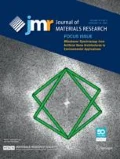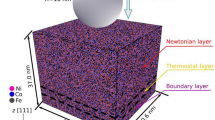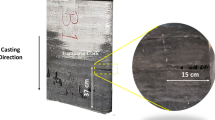Abstract
The present work addresses the competition between dislocation plasticity and stress-induced martensitic transformations in crack affected regions of a pseudoelastic NiTi miniature compact tension specimen. For this purpose X-ray line profile analysis was performed after fracture to identify dislocation densities and remnant martensite volume fractions in regions along the crack path. Special emphasis was placed on characterizing sub fracture surface zones to obtain depth profiles. The stress affected zone in front of the crack-tip is interpreted in terms of a true plastic zone associated with dislocation plasticity and a pseudoelastic zone where stress-induced martensite can form. On unloading, most of the stress-induced martensite transforms back to austenite but a fraction of it is stabilized by dislocations in both, the irreversible martensite and the surrounding austenite phase. The largest volume fraction of the irreversible or remnant martensite along with the highest density of dislocations in this phase was found close to the primary crack-tip. With increasing distance from the primary crack-tip both, the dislocation density and the volume fraction of irreversible martensite decrease to lower values.







Similar content being viewed by others
References
K. Otsuka and C.M. Waymann: Shape Memory Materials (Cambridge University Press, Cambridge, 1998).
H. Funakubo: Shape Memory Alloys (Gordon and Breach, New York, 1987).
J. Frenzel, E.P. George, A. Dlouhy, C. Somsen, M.F.X. Wagner, and G. Eggeler: Influence of Ni on martensitic phase transformations in NiTi shape memory alloys. Acta Mater. 58, 3444 (2010).
J. Frenzel, A. Wieczorek, I. Opahle, B. Maaß, R. Drautz, and G. Eggeler: On the effect of alloy composition on martensite start temperatures and latent heats in Ni–Ti-based shape memory alloys. Acta Mater. 90, 213 (2015).
J. Van Humbeeck: Non-medical applications of shape memory alloys. Mater. Sci. Eng., A 273–275, 134 (1999).
T. Duerig, A. Pelton, and D. Stöckel: An overview of nitinol medical applications. Mater. Sci. Eng., A 273–275, 149 (1999).
V.G. Pushin, V.V. Stolyarov, R.Z. Valiev, T.C. Lowe, and Y.T. Zhu: Nanostructured TiNi-based shape memory alloys processed by severe plastic deformation. Mater. Sci. Eng., A 410, 386 (2005).
R. Valiev, D. Gunderov, E. Prokofiev, V. Pushin, and Y. Zhu: Nanostructuring of TiNi alloy by SPD processing for advanced properties. Mater. Trans. 49, 97 (2008).
C. Grossmann, J. Frenzel, V. Sampath, T. Depka, A. Oppenkowski, C. Somsen, K. Neuking, W. Theisen, and G. Eggeler: Processing and property assessment of NiTi and NiTiCu shape memory actuator springs. Materialwiss. Werkstofftech. 39, 499 (2008).
S.W. Robertson, A.R. Pelton, and R.O. Ritchie: Mechanical fatigue and fracture of Nitinol. Int. Mater. Rev. 57, 1 (2012).
M. Rahim, J. Frenzel, M. Frotscher, J. Pfetzing-Micklich, R. Steegmüller, M. Wohlschlögel, H. Mughrabi, and G. Eggeler: Impurity levels and fatigue lives of pseudoelastic NiTi shape memory alloys. Acta Mater. 61, 3667 (2013).
M. Launey, S.W. Robertson, W. Scott, L. Vien, K. Senthilnathan, Ch. Karthikeyan, P. Chintapalli, and A.R. Pelton: Influence of microstructural purity on the bending fatigue behavior of VAR-melted superelastic Nitinol. J. Mech. Behav. Biomed. Mater. 34, 181 (2014).
S. Fähler, U.K. Rößler, O. Kastner, J. Eckert, G. Eggeler, H. Emmerich, P. Entel, S. Müller, E. Quandt, and K. Albe: Caloric effects in ferroic materials: New concepts for cooling. Adv. Eng. Mater. 14, 10 (2012).
T. Baxevanis and D.C. Lagoudas: Fracture mechanics of shape memory alloys: Review and perspectives. Int. J. Fract. 191, 191 (2015).
S. Gollerthan, D. Herberg, A. Baruj, and G. Eggeler: Compact tension testing of martensitic/pseudoplastic NiTi shape memory alloys. Mater. Sci. Eng., A 481, 156 (2008).
S. Gollerthan, M.L. Young, A. Baruj, J. Frenzel, W.W. Schmahl, and G. Eggeler: Fracture mechanics and microstructure in NiTi shape memory alloys. Acta Mater. 57, 2015 (2009).
S. Gollerthan, M.L. Young, K. Neuking, U. Ramamurty, and G. Eggeler: Direct physical evidence for the back-transformation of stress-induced martensite in the vicinity of cracks in pseudoelastic NiTi shape memory alloys. Acta Mater. 57, 5892 (2009).
C. Maletta, L. Bruno, P. Corigliano, V. Crupi, and E. Guglielmino: Crack-tip thermal and mechanical hysteresis in shape memory alloys under fatigue loading. Mater. Sci. Eng., A 616, 281 (2014).
M.L. Young, S. Gollerthan, A. Baruj, J. Frenzel, W.W. Schmahl, and G. Eggeler: Strain mapping of crack extension in pseudoelastic NiTi shape memory alloys during static loading. Acta Mater. 61, 5800 (2013).
E. Sgambitterra, C. Maletta, and F. Furgiuele: Investigation on crack tip transformation in NiTi alloys: Effect of the temperature. Shape Mem. Superelastic 1, 275 (2015).
T. Baxevanis, Y. Chemisky, and D.C. Lagoudas: Finite element analysis of the plane strain crack-tip mechanical fields in pseudoelastic shape memory alloys. Smart Mater. Struct. 21, 094012 (2012).
T. Baxevanis, A.F. Parrinello, and D.C. Lagoudas: On the fracture toughness enhancement due to stress-induced phase transformation in shape memory alloys. Int. J. Plast. 50, 158 (2013).
T. Baxevanis, C.M. Landis, and D.C. Lagoudas: On the fracture toughness of pseudoelastic shape memory alloys. J. Appl. Mech. 81, 041005 (2014).
T. Baxevanis, C.M. Landis, and D.C. Lagoudas: On the effect of latent heat on the fracture toughness of pseudoelastic shape memory alloys. J. Appl. Mech. 81, 101006 (2014).
G. Stam and E. Giessen: Effect of reversible phase transformations on crack growth. Mech. Mater. 21, 51 (1995).
Y. Freed and L. Banks-Sills: Crack growth resistance of shape memory alloys by means of a cohesive zone model. J. Mech. Phys. Solids 55, 2157 (2007).
T. Ungár, S. Ott, P.G. Sanders, A. Borbély, and J.R. Weertman: Dislocations, grain size and planar faults in nanostructured copper determined by high resolution X-ray diffraction and a new procedure of peak profile analysis. Acta Mater. 46, 3693 (1998).
T. Ungár, I. Dragomir, Á. Révész, and A. Borbély: The contrast factors of dislocations in cubic crystals: The dislocation model of strain anisotropy in practice. J. Appl. Crystallogr. 34, 298 (1999).
G. Ribárik and T. Ungár: Characterization of the microstructure in random and textured polycrystals and single crystals by diffraction line profile analysis. Mater. Sci. Eng., A 528, 112 (2010).
T. Ungár, L. Balogh, and G. Ribárik: Defect-related physical-profile-based X-ray and neutron line profile analysis. Metall. Mater. Trans. A 41, 1202 (2010).
G. Ribárik, B. Jóni, and T. Ungár: Monte-Carlo and least-squares procedures combined for global minimum of the physical parameters in line profile analysis. In preparation.
M.A. Krivoglaz: X-ray and Neutron Diffraction in Nonideal Crystals (Springer, Berlin, Heidelberg, 1996).
M. Wilkens: Theoretical aspects of kinematical X-ray diffraction profiles from crystals containing dislocation distributions. In Fundamental Aspects of Dislocation Theory, Vol. II, J.A. Simmons, R. de Wit, and R. Bullough, eds.; (Nat. Bur. Stand. (US), Spec. Publ. No. 317, Washington, DC, USA, 1970); p. 1195.
I. Groma, T. Ungár, and M. Wilkens: Asymmetric X-ray line broadening of plastically deformed crystals. I. Theory. J. Appl. Crystallogr. 21, 47 (1988).
J.E. Bailey and P.B. Hirsch: The dislocation distribution, flow stress, and stored energy in cold-worked polycrystalline silver. Philos. Mag. 5, 485 (1960).
T. Ungár and G. Tichy: The effect of dislocation contrast on X-ray line profiles in untextured polycrystals. Phys. Status Solidi 147, 425 (1999).
G. Csiszár, K. Pantleon, H. Alimadadi, G. Ribárik, and T. Ungár: Dislocation density and Burgers vector population in fiber-textured Ni thin films determined by high-resolution X-ray line profile analysis. J. Appl. Crystallogr. 45, 61 (2012).
B. Jóni, T. Al-Samman, S.G. Chowdhury, G. Csiszár, and T. Ungár: Dislocation densities and prevailing slip-system types determined by X-ray line profile analysis in a textured AZ31 magnesium alloy deformed at different temperatures. J. Appl. Crystallogr. 46, 55 (2013).
T. Ungár, G. Tichy, J. Gubicza, and R.J. Hellmig: Correlation between subgrains and coherently scattering domains. Powder Diffr. 20, 366 (2005).
Gy. Zilahi, T. Ungár, and G. Tichy: A common theory of line broadening and rocking curves. J. Appl. Crystallogr. 48, 418 (2015).
S. Nemat-Nasser, J-Y. Choi, W-G. Guo, and J.B. Isaacs: Very high strain-rate response of a NiTi shape-memory alloy. Mech. Mater. 37, 287 (2005).
S. Nemat-Nasser and W-G. Guo: Superelastic and cyclic response of NiTi SMA at various strain rates and temperatures. Mech. Mater. 38, 463 (2006).
W.G. Guo, J. Su, Y. Su, and S.Y. Chu: On phase transition velocities of NiTi shape memory alloys. J. Alloys Compd. 501, 70 (2010).
L.B. Freund and J.W. Hutchinson: High strain-rate crack growth in rate-dependent plastic solids. J. Mech. Phys. Solids 33, 169 (1985).
L.B. Freund, J.W. Hutchinson, and P.S. Lam: Analysis of high-strain-rate elastic-plastic crack growth. Eng. Fract. Mech. 23, 119 (1986).
G.T. Grey, III: High-strain-rate deformation: Mechanical behavior and deformation substructures induced. Annu. Rev. Mater. Res. 42, 285 (2012).
ACKNOWLEDGMENTS
T.U. is grateful to the Humboldt Foundation of Germany for supporting this research. JF, SG and GE acknowledge funding by the German Research Association (DFG) through project C1 of SPP 1544 (Ferroic Cooling). G.R. gratefully acknowledges the support of the János Bolyai Research. Fellowship of the Hungarian Academy of Sciences. The authors thank Dr. G. Csiszár for the assistance in carrying out the X-ray diffraction experiments.
Author information
Authors and Affiliations
Corresponding author
Additional information
Dedicated to the 80th Birthday of Professor Haël Mughrabi.
This author was an editor of this journal during the review and decision stage. For the JMR policy on review and publication of manuscripts authored by editors, please refer to http://www.mrs.org/editor-manuscripts/.
A previous error in this article has been corrected. For details, see 10.1557/jmr.2017.459
Rights and permissions
About this article
Cite this article
Ungár, T., Frenzel, J., Gollerthan, S. et al. On the competition between the stress-induced formation of martensite and dislocation plasticity during crack propagation in pseudoelastic NiTi shape memory alloys. Journal of Materials Research 32, 4433–4442 (2017). https://doi.org/10.1557/jmr.2017.267
Received:
Accepted:
Published:
Issue Date:
DOI: https://doi.org/10.1557/jmr.2017.267




